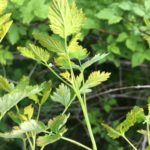Blackberries and raspberries have become increasingly popular crops for growers in the state. There are a number of issues with bramble crops. Blackberries are only marginally cold hardy for central and northern Indiana, often suffering damage at temperatures of -10˚F or below. Growers using a trellis and winter protection are having success avoiding winter injury, but damage is common where plants are not protected. Blackberries usually show “delayed winter injury” rather than complete death of above ground portions. We’re seeing lots of that this year in the Lafayette area following temperatures in the mid to high teens below zero. Along with winter injury is cane blight, especially on thornless blackberries. This disease seldom expresses itself unless winter injury occurs, even though the canes may be infected. Red necked cane borer is a common insect pest that also predisposes canes to winter injury. Often canes die above the location on the cane where the borers are present following cold winters.
Orange rust is another potential disease problem of concern. It infects black raspberry and blackberry, but not red raspberry. Orange rust is a systemic disease and once a plant is infected, it cannot be cured. Rouging infected plants from the plantings and nearby woods is the best way to minimize spread.
Raspberries seldom suffer significant winter injury. Most common varieties of red and black raspberries are hardy to zone 5 and can withstand temperatures near -20˚F. And fortunately they are not highly susceptible to cane blight or red necked cane borer. However, black raspberries are susceptible to orange rust and anthracnose.
Finally, the new insect pest spotted wing Drosophila has become a major concern for bramble growers (and most other berry growers). This pest is very fond of red raspberries and will select them above most other fruits. They are also happy to infest blackberries. Controlling SWD is very difficult, even with frequent insecticide sprays because the life cycle is as short at 4 days from egg to adult, so populations can become very large very quickly.
If you are considering growing brambles, give some serious thoughts to what crops you grow and how you plan to manage the issues discussed here.
- Winter injury in thornless blackberry
- Discolored and stunted shoots on winter injured blackberry
- Orange rust on thornless blackberry
- Red necked cane borer damage on thornless blackberry
- Orange rust on black raspberry




